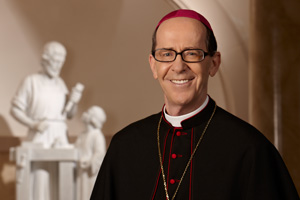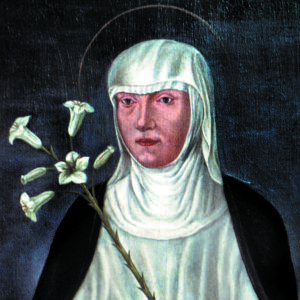
Fourth in a series

[dropcap type=”4″]S[/dropcap]he was a Dominican but not a religious. She held no leadership position in the Church or society but was one of the most influential persons of the 14th century. She negotiated peace between City States of central Italy. She exhorted Pope Gregory XI to return to Rome after more than half a century of popes being exiled in Avignon. Who would have guessed that this 23rd of 24 children, born to Jacopo and Lapa Benincasa in Siena, would have such a great impact on the world in her lifetime and far more thereafter? All this she did as a lay person.
A Dominican Tertiary
Catherine of Siena was closely associated with the Dominicans, having become a member of the Mantellate, a Tertiary organization that assisted lay members to pursue holiness of life while remaining in the world and strengthened there by the charism, example and counsel of Dominican Sisters and Friars.
In this year of consecrated life, it is good not only to honor men and women religious but also the many laity who are closely associated with their charisms and apostolates. In this regard, followers of St. Francis include more than his Friars, Sisters and the Poor Clare Nuns; there are also lay associates known as secular order Franciscans. Similarly, the Benedictines have their Oblates, Carmelites their Third Order, Passionists their Associates, and so it goes. Moreover, the laity who associate themselves closely with a particular Institute of Consecrated Life are not called to holiness any less than those who belong fully to each Institute. Of this truth, St. Catherine of Siena is a prime example.

More than being a ‘groupie’
Tertiaries don’t just tag along occasionally with religious or, when convenient, join them for prayer and days of reflection. They become tertiaries only after a time of formal preparation, often lasting up to five years or more, a time of reading, study and spiritual direction, followed by a formal ceremony of profession which, while not a religious vow, formalizes nonetheless their association with a specific institute.
Wearing a religious habit is not customary for tertiaries, although they may have permission to be buried in one. Sometimes, however, they do wear a distinctive symbol or garb, designed just for them, as was the case of Catherine, who assumed a mantel in which we often see her clad in pictures. Of course, clothes do not make a saint; nor does the tertiary profession insure holiness. Nonetheless, a deep attraction to a unique “way” of Christian spirituality and a daily effort to follow that way, does help one to imitate Christ more closely and to fulfill one’s lay vocation in Him. This was certainly true for St. Catherine, as evidenced in her apostolic endeavors and especially in her intense prayer.
Drawing life from the Sacred Liturgy
Catherine lived most of her life, just down the street in Siena from the Church of St. Dominic. There, from childhood on, she spent many hours in prayer, participated in daily Mass, received the sacraments, was instructed through Dominican preaching, and in other ways entered into a close friendship with Jesus.
She was deeply drawn to live a solitary life, away from the world, knowing that Jesus, in a vision, had called her to be His bride. But the Lord made it clear to her that she was to live her vocation in the world, where she would combine prayer and action for the sake of God’s Kingdom.
We know a great deal about this popular Saint from Siena from her own writings, especially her book known as “The Dialogue,” and also collections of her letters and of her prayers. There is such theological and spiritual depth in these writings that she, along with St. Teresa of Avila, became the first women to be declared doctors of the Church by Blessed Pope Paul VI in AD 1970. Whoever uses her prayers for meditation soon discovers rich food for mind and imagination, soul and heart. A profound theological depth reflects the impact on her life of daily Mass, its biblical readings and the solid preaching that she absorbed like a sponge takes in water. From these liturgical sources her vocation and mission from Christ were constantly nourished. And so it can be for you and me.
In the Church today, also here in our own diocese, we are blessed to have many lay people who, like St. Catherine, draw daily inspiration and support in their love of God and neighbor by closely associating with Religious Institutes. We give thanks to God for each of them in this Year of Consecrated Life, mindful of how their fidelity can inspire the rest of us on our unique path to holiness in Christ.





![[VIDEO] Make Sunday feel like Sunday again](https://www.catholicsun.org/wp-content/uploads/2021/04/2021-YOUTUBE-BISHOP-MESSAGE-THUMBNAIL-ENGLISH-218x150.png)